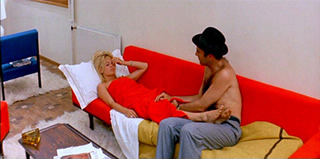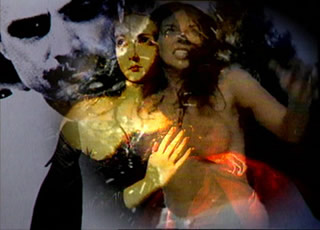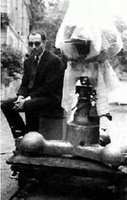


"I like gods... I know exactly how they feel," Jeremy Prokosch (Jack Palance) exults in Jean-Luc Godard's LE MEPRIS (1963) as he watches rushes from THE ODYESSY, a project being filmed at Cinecitta studios by the legendary Fritz Lang. To show his contempt for Lang's artistic approach the supercilious producer throws cans of exposed film like a discus thrower in Ancient Greece, an appropriate image in a film stuffed with ironic parallels between the ancient and modern worlds. His impatience with the world and everyone in it will lead to his death as he drives himself and Brigitte Bardot under the crushing wheels of a double tanker truck. Palance is perfectly cast in the role while Godard comments on his own artistic subservience to exploitation moguls Carlo Ponti and Joseph E. Levine, who demanded he add a prologue with Bardot in the nude. Godard aestheticized the sell-out by stylizing the image with colored gels.
Godard's self critique also implicates Jess Franco as one of the countless Euro-schlock directors who were practicing their craft at the time. Franco cited Godard, Bunuel and Fritz Lang in his own pantheon in NECRONOMICON, several years later. The fact that Lang is playing himself here adds another allusive layer of meanings. He's a beleagured artist here, having to absorb the humiliations of his overbearing producer. He compares Prokosch to the Nazis whom Lang in real life evaded after they attempted to interfere with his TESTAMENT OF DR. MABUSE. In a further irony Franco would just about finish off the MABUSE mythology with his grade Z LA VENGANZA DEL DR MABUSE (1971), which Soldedad Miranda may have appeared in had she lived. Franco has some interesting comments on Godard's influence in his interview on the recent BU SUCCUBUS DVD.
LE MEPRIS concerns the artistic and ethical compromises an artist working in commercial, mainstream cinema must make in order to survive. For instance, the film centers on the destruction of the marriage of a successful screenwriter (the excellent Michel Piccoli) whose last project was TOTO VS HERCULES. Fritz Lang looks at him with a degree of pity, noting that "One must suffer."
The careers of Franco and Godard would have numerous parallels: they both were strongly influenced by classic Hollywood genre cinema during their 1960s period and as Godard worked with Lang, Franco would work with another giant of world cinema, Orson Welles. Godard's cinema experiments, though, would become increasing centered around the world of Realpolitik, whereas Franco created his own alternate universe of Erotica, sometimes of the hardcore variety. It's probably no coincidence that both filmmakers were condemned by the Vatican: in 1971 Franco was named, along with Bunuel, as one of the directors most dangeous for Catholics, while Godard's scandalous HAIL MARY! was trashed by Pope John Paul II. They both began their feature filmmaking career in the late 50s and are both now working in digital media. Godard's massive investigation into the nature of the image culminates in his HISTORIES DU CINEMA (1988-1998) [above-right] while Franco's BROKEN DOLLS, HELTER SKELTER and SNAKEWOMAN also attempt to reconfigure cinema history in a display of the limitations and possiblities of representation.
The must-have Critereon Edition of LE MEPRIS contains a very amusing interview with regular Franco collaborator Howard Vernon, one of the numerous compelling reasons for acquiring this two disc set.
COMMENTARY COPYRIGHT ROBERT MONELL: 2006.

No comments:
Post a Comment